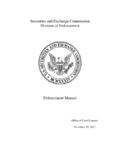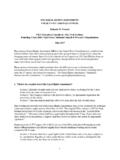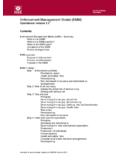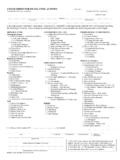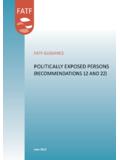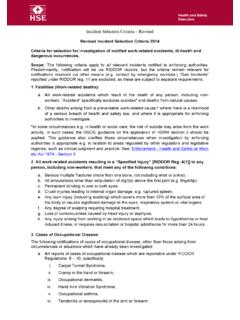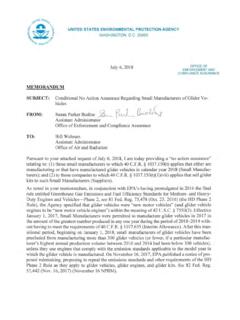Transcription of Enforce bans on tobacco advertising, promotion and …
1 2223 WHO REPORT ON THE GLOBAL tobacco EPIDEMIC, 2013 WHO REPORT ON THE GLOBAL tobacco EPIDEMIC, 2013 Enforce bans on tobacco advertising, promotionand sponsorshipAlthough precise calculations have not been made, the best estimate is that the tobacco industry spends tens of billions of US dollars worldwide each year on tobacco advertising, promotion and sponsorship (TAPS) (7). In the United States alone, the tobacco industry spends more than US$ 10 billion annually on TAPS activities (8). To sell tobacco companies spend billions of us dollars on advertising, promotion and sponsorship every yearTo sell a product that kills up to half of its users requires extraordinary marketing savvy, and tobacco companies are some of the most manipulative product sellers and promoters in the product that kills up to half of its users requires extraordinary marketing savvy, and tobacco companies are some of the most manipulative product sellers and promoters in the world.
2 They are increasingly aggressive in circumventing prohibitions on TAPS that are designed to curb tobacco use. The requirements of the WHO Framework Convention on tobacco Control (WHO FCTC) for a comprehensive ban on TAPS are intended to counter this. WHO introduced the MPOWER measures to support countries in building capacity to implement these bans. tobacco advertising, promotion and sponsorship increase the likelihood that people will start or continue to smokeAlthough TAPS activities are designed to have broad appeal to consumers in all demographic groups, and especially among current smokers, specific efforts are made to persuade non-smokers to start. As a result, key target populations for TAPS include youth, who are at the age when people are most likely to start regular smoking (9, 10), and women, who in most countries are less likely to be current smokers than men (10).
3 Young people are especially vulnerable to becoming tobacco users and, once addicted, will likely be steady customers for many years. Adolescents are at a critical transitional phase in their lives, and TAPS activities communicate messages that using tobacco products will satisfy their social and psychological needs ( popularity, peer acceptance and positive self-image) (10, 11). People who smoke are generally extremely loyal to their chosen brand of cigarettes, so their choice of brand during their smoking initiation period is especially important (12), and becomes crucial to the ability of tobacco companies to maintain them as life-long customers (10). Exposure to TAPS, which usually occurs at very young ages (before age 11 and often earlier), increases positive perceptions of tobacco and curiosity about tobacco use.
4 It also makes tobacco use seem less harmful than it actually is, and influences beliefs and perceptions of tobacco use prevalence (13, 14, 15), which increase the likelihood that adolescents will start to smoke (10, 16, 17).2425 WHO REPORT ON THE GLOBAL tobacco EPIDEMIC, 2013 WHO REPORT ON THE GLOBAL tobacco EPIDEMIC, 2013 Women, who in many countries have traditionally not used tobacco , are viewed by the tobacco industry as an enormous potential emerging market because of their increasing financial and social independence, and have been targeted accordingly (1). As a result, smoking among women is expected to double worldwide from 2005 to 2025 (18). Many niche cigarette brands have been developed to appeal specifically to women ( Virginia Slims, Eve), and existing brands have been restyled to increase their appeal among women ( Doral).
5 In South Korea, these strategies increased smoking rates among women from to 13% between 1988 and 1998 (19). tobacco companies target low- and middle-income countriesThe tobacco industry is also increasingly targeting people in low- and middle-income countries, especially youth and women (20). tobacco use is stable or declining slightly in most higher-income countries, but is increasing in many lower-income countries in some cases rapidly as they continue to develop economically (21). To capture the many potential new users in lower-income countries, the tobacco industry is rapidly expanding TAPS activities in these countries, using tactics refined and perfected over decades in high-income countries (20). The tobacco industry has become adept at tailoring these advertising and promotion tactics to the specific market environments of low- and middle-income countries (20).
6 Examples of country-specific targeting abound. In Guinea, attractive young women are hired by tobacco companies as marketing executives, but in reality serve as so-called cigarette girls whose duty is to promote cigarettes at nightclubs, in front of retail shops and in other public places (22). A similar strategy is used in Thailand, where young women are hired as ambassadors of smoking to conduct tobacco company promotions (23). In both Indonesia and Senegal, most of the public basketball courts in these countries cities are painted with the logos of cigarette brands (22). In Indonesia, which has yet to become a Party to the WHO FCTC, several youth-friendly international music stars have performed in concerts sponsored by tobacco companies (24).
7 tobacco sales and promotions continue to be popular in bars, caf s and nightclubs in all WHO regions, with larger establishments more likely to display tobacco advertising and participate in tobacco company promotions (25). In Brazil, an interactive gaming machine in many clubs, bars and other locations popular with young people have players capture an on-screen moving Marlboro logo to win prizes; the machine also gathers players email addresses to enable the sending of promotional information (26).To capture new users in lower-income countries, the tobacco industry is rapidly expanding TAPS activities, using tactics perfected in high-income Marlboro had been the world s top-selling cigarette brand since the early 1970s, Philip Morris began conducting sophisticated market research in different countries and regions in the 1990s to develop advertising and promotional strategies that focused on the youth market.
8 These targeted efforts further intensified Marlboro s brand appeal among young adults worldwide, solidifying its position as the most widely recognized, most popular and largest selling cigarette brand globally (27).Advertising, promotion and sponsorship activities normalize and glamourize tobacco useTAPS falsely associates tobacco use with desirable qualities such as youth, energy, glamour and sex appeal (28). To attract new users, the industry designs marketing campaigns featuring active and attractive young people enjoying life with tobacco (10, 29).TAPS also creates additional obstacles that blunt tobacco control efforts. Widespread TAPS activities normalize tobacco by depicting it as being no different from any other consumer product.
9 This increases the social acceptability of tobacco use and makes it more difficult to educate people about tobacco s harms (10). It also strengthens the tobacco industry s influence over the media, as well as sporting and entertainment businesses, through tens of billions of dollars in annual spending on TAPS ,7503,500875 KilometersPercentage of youth having noticed tobacco advertising on billboards during the last 30 daysData Source: World Health OrganizationMap Production: Public Health Informationand Geographic Information Systems (GIS)World Health OrganizationThe boundaries and names shown and the designations used on this map do not imply the expression of any opinion whatsoeveron the part of the World Health Organization concerning the legal status of any country, territory, ci ty or area or of its authorities, or concerning the delimitation of its frontiers or boundaries.
10 Dotted and dashed lines on maps represent approximate border linesfor which there may not yet be full agreement. WHO 2013. All rights (%) 5051 6061 70>70 Data not availableNot applicableData source: latest available Global Adult tobacco Surveys (GATS) and Global Youth To bacco Survey (GYTS)TEENAGERS ARE ExPOSED TO BILLBOARD tobacco ADVERTISING AT AN ALARMING MAGNITUDE (DATA FROM THE GLOBAL YOUTH tobacco SURVEY)Youth (13-15 years old) thatnoticed tobacco advertisingon billboards during the last30 days (%)Source: (30).Notes: The range of survey years (data year) used for producing these maps is 2004-2011. The following countries and territories have conducted subnational or regional level GYTS: Afghanistan, Algeria, Benin, Bolivia (Plurinational State of), Brazil, Burkina Faso, Cameroon, Central African Republic, Chile, China, Colombia, Democratic Republic of the Congo, Ecuador, Ethiopia, Gambia, Guinea-Bissau, Honduras, Iraq, Liberia, Mozambique, Nicaragua, Nigeria, Pakistan, Poland, Somalia, United Republic of Tanzania, Uzbekistan, Zimbabwe, and West Bank and Gaza ,7503,500875 KilometersPercentage of youth having noticed tobacco advertising on billboards during the last 30 daysData Source: World Health OrganizationMap Production.










